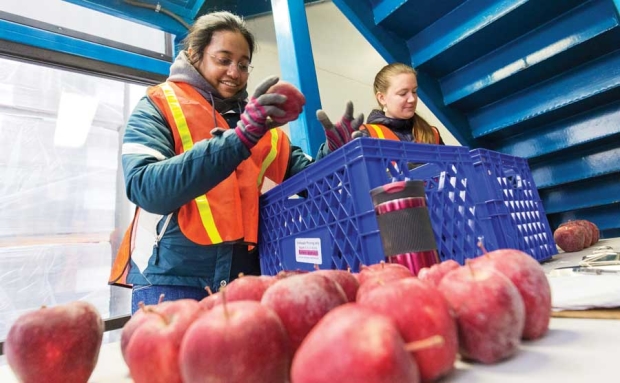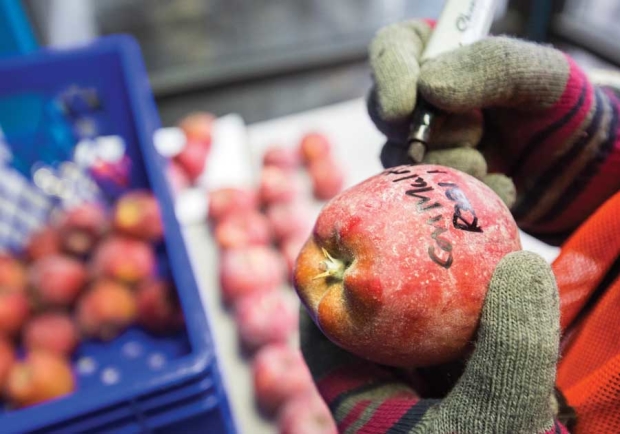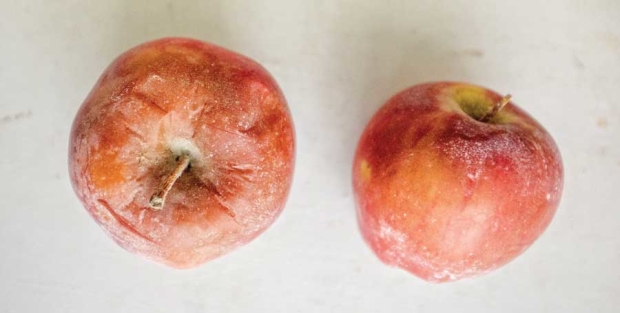
Dr. Parama Sikdar, left, inspects Red Delicious apples for evidence of rot in a cold storage facility in Wenatchee, Washington, with Emmi Klarer. Sikdar, a plant pathologist for the WSU Tree Fruit Research and Extension Center, is looking for evidence of rots from the postharvest diseases caused by Phacidiopycnis washingtonensis and Sphaeropsis pyriputrescens. (TJ Mullinax/Good Fruit Grower)
Dr. Parama Sikdar and her assistant Emmi Klarer inspected thousands of Red Delicious apples one by one, huddling over a table in a Stemilt Growers warehouse stairwell in Wenatchee, Washington.
“It’s warmer in here,” Sikdar said, still bundled in a beanie and thick hoodie to ward off the chill from the cold storage just on the other side of the door.
Besides, the window light helped them spot evidence of rot, which they documented with a black Sharpie right on the fruits’ skin.
Sikdar, a plant pathologist with the Washington State University Tree Fruit Research and Extension Center, is part of a team of Wenatchee researchers trying to help growers stave off three types of fungal diseases that prompted China to temporarily cease imports of U.S. apples in 2012.
Meanwhile, other team members search for rot-resistant alternatives to the ubiquitous Manchurian crab apple pollinizers that also maybe won’t pop so darn many tractor tires.
The group is in the second year of a five-year $1.9 million U.S. Department of Agricultural Foreign Agricultural Service grant from the Technical Assistance for Specialty Crops program.
After one year of work, Sikdar and her colleagues have determined that a combination of aggressive Manchurian pruning and post-harvest fungicide treatments “significantly” reduce the incidence of two of those three fungal infections, speck rot (Phacidiopycnis washingtonensis) and sphaeropsis rot (Sphaeropsis pyriputrescens), in apples as they sit in cold storage. Now, Sikdar is measuring how much each technique — pruning and fungicide treatment — works individually.
In the meantime, she recommends growers prune Manchurians after twig dieback in a vertical shape to reduce overhanging limbs, avoid using overhead sprinklers as much as possible, remove the trimmings from the orchard to limit the spread of the disease and remove fruit mummies after harvest.
Manchurian connection
Manchurian crab apples and Snowdrift crab apples are the most common pollinizers in Washington’s apple industry. Manchurians bloom early in the season, which is why growers began using them in the 1980s, along with Snowdrifts that bloom later.
In the past, growers have been hit-and-miss with pruning the spindly, unruly Manchurians, choosing to spend their money on the fruit trees instead. Afterall, more growth on pollinators just means more flowers for the bees.
Meanwhile, Manchurian branches are so hard and thorny they’ve been known to pop tractor tires. “They’re just like having nails out in your orchard,” said Denny Hayden, a Pasco area grower.
Hayden had always pruned his Manchurians, just to keep them from taking up too much space in his high-density blocks.
He first tried using solid foam tires, but those made tractors hard to drive. He now instructs crews to haul away the prunings and burn them, an extra labor cost he would rather pay than continually fix flats.
But some growers didn’t prune them at all. The unkempt condition led to dead and decaying branches that gave the opportunistic fungi a place to fester. (Read and Watch: How to manage Manchurian crab apples to reduce diseases.)
The rots affect commercial cultivars of apple trees, too, but growers had always pruned those as part of their orchard management and kept the diseases at bay without even realizing it.
In 2012 on shipments of U.S. apples, Chinese fruit inspectors found three rots — speck, sphaeropsis and a third kind called bull’s-eye rot (Neofabraea perennans) — previously unseen in their country. They shut down imports for two years.
U.S. officials suspected some politics behind the move but began studies to set the record straight nonetheless, said Mike Willett, manager of the Washington State Tree Fruit Research Commission.
Though they had conducted no trials, researchers in Washington already knew that pruning and postharvest fungicide reduce the incidence of speck and sphaeropsis, Willett said. The existing work, plus the new tests by Sikdar, helped convince China to reopen the market in November 2014.
Today, pruning is mandatory for growers planning to ship to China, Willett said. “They need to know if they’re going to export fruit to China, they have to prune the crabs. It’s not optional.”
The risk is high. Speck and sphaeropsis rot have been known to cause orchard losses of up to 24 percent in isolated blocks.
The pathogens spread by rain and irrigation water splashing from infected dead twigs and fruit mummies left to overwinter as pycnidia on those underpruned Manchurians.
Making matters worse, growers won’t see the rot in the orchards. The symptoms don’t show up until after at least 60 days in cold storage and usually not until 90 or more.
Through May this year, Sikdar will be comparing the incidence of speck and sphaeropsis rot on three categories of apples — those picked from orchards with pruned Manchurians and treated by fungicide, those from pruned orchards without fungicide and a control group of apples with neither method.
So far, pruning is better than nothing but pruning plus fungicide works the best, she said.
In the future, Sikdar will study the biology of bull’s-eye rot, another postharvest fungal infection, and possible control methods, continuing work already begun under the grant by Christian Aguilar, a WSU doctoral student in Wenatchee.
Then, she will begin investigating how some of her research applies to pears, which have trouble with similar fungi.
A companion scientist, Dr. Stefano Musacchi, also at the Wenatchee center, is conducting trials to find a new pollinizer that growers may be able to use instead of Manchurians.
Sikdar and Klarer go through about 3,000 apples per month, harvested from test blocks in Yakima, Othello and Mallott. Sikdar keeps the fruit in Stemilt’s research and development warehouse along the banks of the Columbia River.

Dr. Parama Sikdar marks a Red Delicious apple that may have evidence of a postharvest rot on the calyx end of the fruit in a cold storage facility in Wenatchee, Washington. (TJ Mullinax/Good Fruit Grower)
They bundle up to open their storage unit and haul out a pallet of blue boxes, each filled with fruit, taking a few at a time to the warmer confines of the stairwell.
Apple by apple, they search the stem and calyx for signs of the rots, which appear as brown, rubbery spots on the skin. Sphaeropsis, as an added indicator, supposedly smells like bandages, Sikdar said.
They take the infected apples back to the laboratory across town to verify the fungal strains by placing tissue samples on culture plates. The rest go back in storage until the next monthly inspection.
Over time, Sikdar has developed a keen eye for rot. But sometimes symptoms are hard to spot, she said, and even then may look like other defects, such as sunburn, leading Sikdar to speculate the diseases have been around for years undetected.
“It’s a very tricky one, which is why it went missing for so long,” Sikdar said. •
– by Ross Courtney
Rot v. Sunburn

Examples of postharvest rot, left, and sunburn, right, on Red Delicious apples. Postharvest diseases caused by Phacidiopycnis washingtonensis and Sphaeropsis pyriputrescens can look similar to sunburn on the surface after a few months in RA storage. (TJ Mullinax/Good Fruit Grower)






Leave A Comment